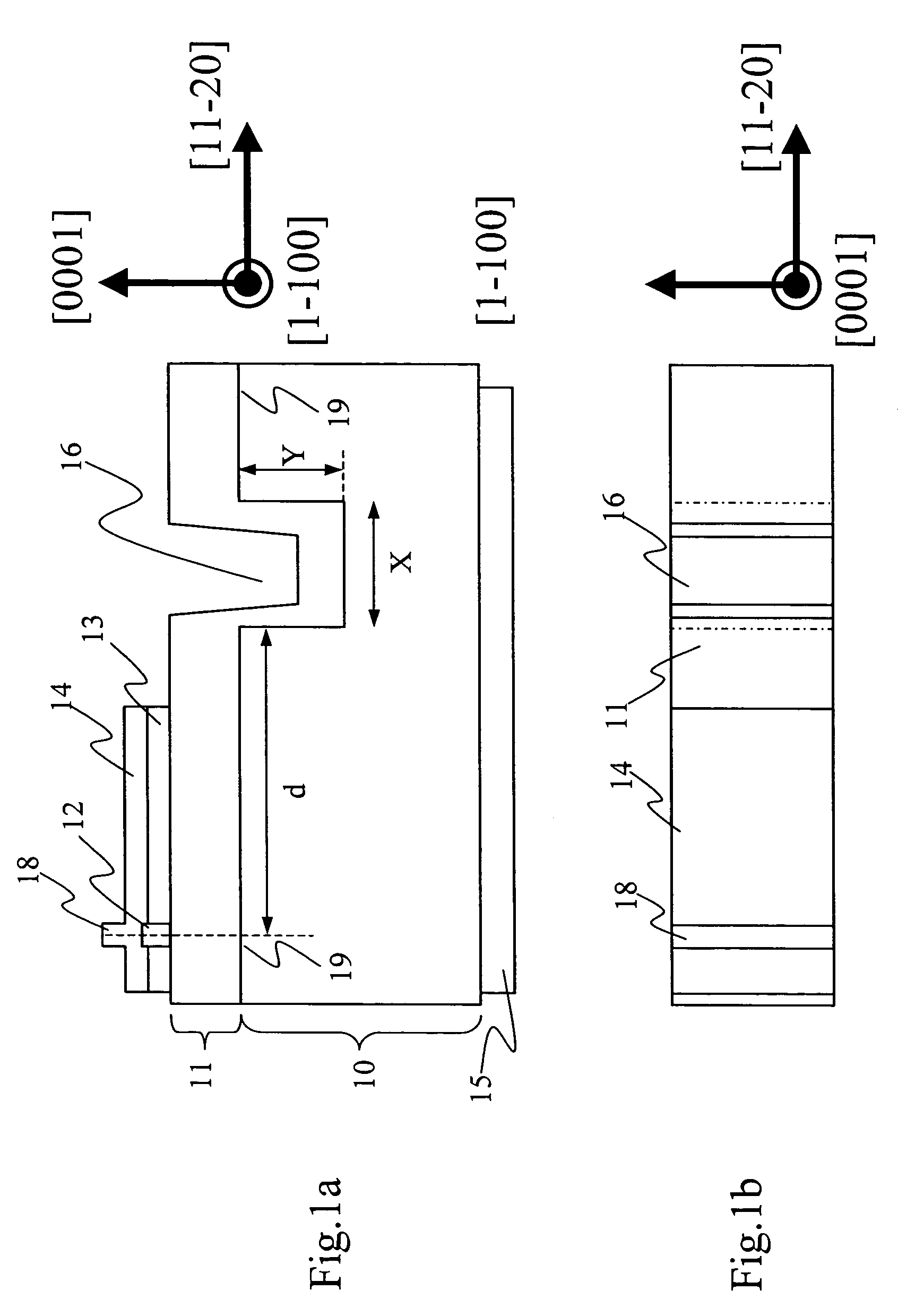Method for fabrication of semiconductor device
a semiconductor laser and fabrication method technology, applied in the direction of semiconductor lasers, lasers, semiconductor laser structural details, etc., can solve the problems of low yield, difficult to further divide the bar into discrete nitride semiconductor laser devices, and low yield, so as to prevent crack development and good surface flatness
- Summary
- Abstract
- Description
- Claims
- Application Information
AI Technical Summary
Benefits of technology
Problems solved by technology
Method used
Image
Examples
first embodiment
[0111]Now, a first embodiment of the present invention will be described with reference to the relevant drawings. This embodiment deals with, as an example of a nitride semiconductor device, a nitride semiconductor laser device. It should be understood, however, that the present invention is applicable to any other type of nitride semiconductor device. FIG. 1a is a schematic sectional view of the nitride semiconductor device of this embodiment, and FIG. 1b is a top view of FIG. 1a. FIG. 3b is a schematic sectional view of a processed substrate 10 before a nitride semiconductor thin film is grown thereon in this embodiment of the invention, and FIG. 3a is a top view of FIG. 3b. In these figures, plane orientations are indicated together. The nitride semiconductor laser device shown in FIGS. 1a and 1b is produced, for example, by laying, on top of the processed substrate 10 shown in FIGS. 3a and 3b, a nitride semiconductor growth layer 11 having a structure as shown in FIG. 19.
[0112]T...
second embodiment
[0146]Next, a second embodiment of the present invention will be described with reference to the relevant drawings. This and the following embodiments both deal with, as an example of a semiconductor device, a nitride semiconductor laser device. It should be understood, however, that the present invention is applicable to any other type of semiconductor device. FIG. 11a is a schematic sectional view of the semiconductor device of this embodiment, and FIG. 11b is a top view of FIG. 11a. FIG. 12b is a schematic sectional view of a processed substrate 10 before a nitride semiconductor thin film is grown thereon in this embodiment of the invention, and FIG. 12a is a top view of FIG. 12b. In FIGS. 11a, 11b, 12a, and 12b, plane orientations are indicated together.
[0147]In the nitride semiconductor laser device of this embodiment, a processed substrate 10 formed of a nitride semiconductor substrate having engraved regions 16 formed as depressed portions thereon further has SiO2 walls forme...
third embodiment
[0181]Next, a third embodiment of the present invention will be described with reference to the relevant drawings. FIG. 16 is a schematic sectional view of part of a wafer having nitride semiconductor thin films grown on top of a processed substrate 10 in this embodiment. In this embodiment, unlike in the second embodiment, no SiO2 walls are formed along the edges of ridges 19, i.e., the non-engraved regions, on the processed substrate 10.
[0182]FIG. 16 is a schematic sectional view of a wafer having nitride semiconductor thin films grown on such a processed substrate 10 having engraved regions 16 formed thereon. As shown in FIG. 16, the nitride semiconductor thin films grow as top growth portions 95 in central portions of top portions 91 of the ridges 19, as inflow prevention portions 94 in both edge portions of the top portions 91 of the ridges 19, near the engraved regions 16, and as engraved region growth portions 97 on side portions 92 and floor portions 93 in the engraved regio...
PUM
| Property | Measurement | Unit |
|---|---|---|
| width | aaaaa | aaaaa |
| width | aaaaa | aaaaa |
| opening width | aaaaa | aaaaa |
Abstract
Description
Claims
Application Information
 Login to View More
Login to View More - R&D
- Intellectual Property
- Life Sciences
- Materials
- Tech Scout
- Unparalleled Data Quality
- Higher Quality Content
- 60% Fewer Hallucinations
Browse by: Latest US Patents, China's latest patents, Technical Efficacy Thesaurus, Application Domain, Technology Topic, Popular Technical Reports.
© 2025 PatSnap. All rights reserved.Legal|Privacy policy|Modern Slavery Act Transparency Statement|Sitemap|About US| Contact US: help@patsnap.com



